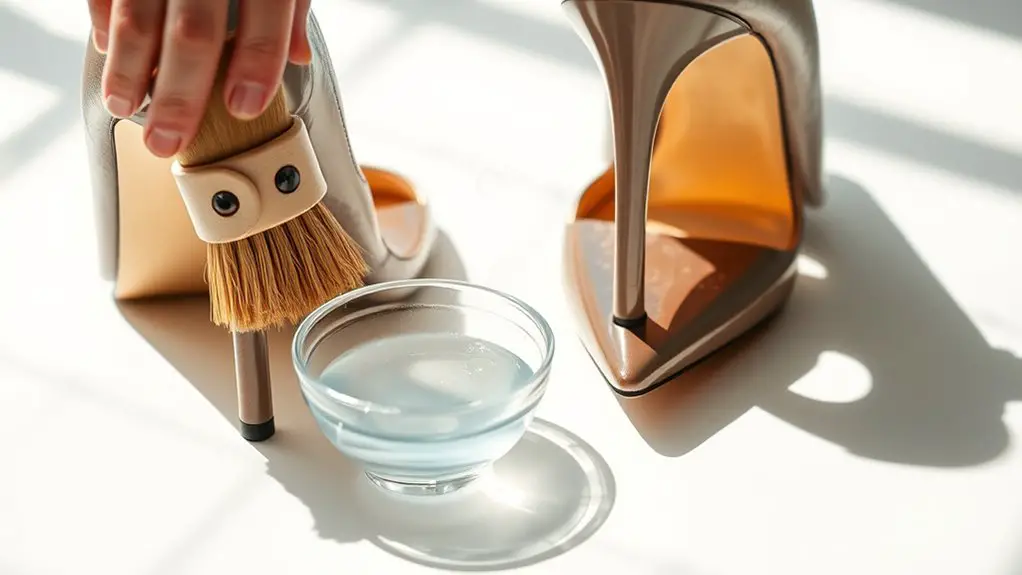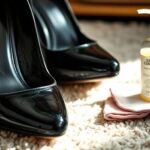To clean stained or dirty heels, start by identifying the material. For leather, use mild soap and a soft cloth; for suede, gently brush scuff marks with a suede brush. Patent leather can be cleaned with rubbing alcohol on a damp cloth. Fabric heels benefit from a solution of mild detergent and warm water. Always follow up with a waterproofing spray for protection. Discover further tips for maintaining your heels’ pristine condition.
Assessing the Type of Material
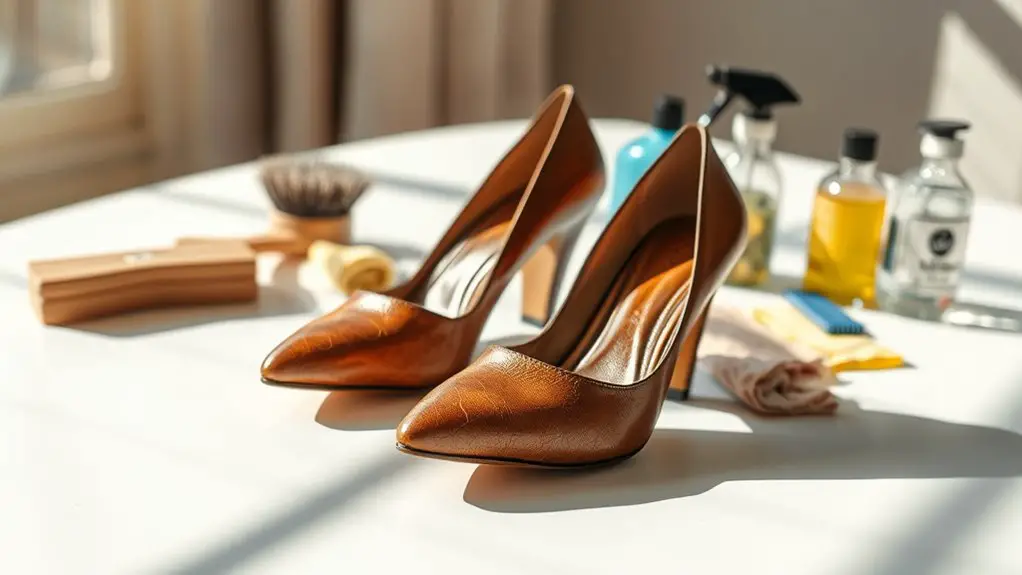
When it comes to cleaning heels, understanding the type of material is crucial, as different fabrics and finishes require specific care methods. Each material has unique characteristics that dictate how you should approach cleaning. For example, leather is durable but can be sensitive to moisture, while suede offers a soft texture but is prone to staining. If you’ve got patent leather, its glossy finish can be easily scratched, presenting specific cleaning challenges.
Before you start, assess your heels closely. Check for material types like fabric, synthetic blends, or rubber soles that may require different cleaning agents. Remember, the wrong approach can damage the material, leading to irreversible harm. Knowing your heels’ material characteristics not only helps you choose the right cleaning technique but also guarantees longevity. So, take a moment to identify your heels’ material, and you’ll set yourself up for cleaning success.
Gathering Your Cleaning Supplies
Before diving into the cleaning process, it’s essential to gather the right supplies to guarantee your heels are treated appropriately. Having the proper cleaning tools and stain removers on hand will make the job easier and more effective. Here’s a list of essentials you’ll need:
Gather the right cleaning supplies to ensure your heels receive proper care and restoration.
- A soft-bristle brush for gentle scrubbing
- Microfiber cloths to wipe away dirt and moisture
- Mild detergent or specialized shoe cleaner for tough stains
- Rubbing alcohol or vinegar for stubborn marks
- A waterproofing spray to protect your heels post-cleaning
These items will help you tackle various stains and maintain the integrity of your heels. Make sure to choose stain removers suited for the material of your shoes to avoid damage. With the right supplies gathered, you’ll be ready to restore your heels to their former glory.
Spot Cleaning Scuff Marks
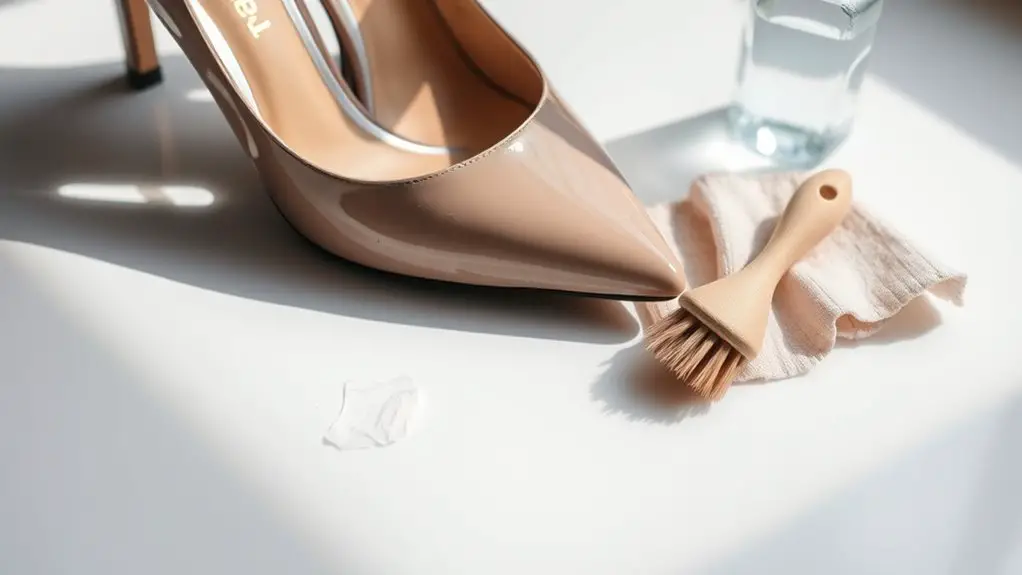
Now that you’ve gathered your cleaning supplies, it’s time to tackle those scuff marks that can mar the appearance of your heels. For effective spot cleaning, start by identifying the type of material your heels are made from. This will guide you in choosing cleaners that won’t damage the surface.
Here’s a quick reference table to help you choose the right cleaner:
| Material | Recommended Cleaner | Application Method |
|---|---|---|
| Leather | Mild soap and water | Use a soft cloth to wipe |
| Suede | Suede brush | Gently brush the scuff mark |
| Patent Leather | Rubbing alcohol | Dampen a cloth and wipe gently |
| Fabric | Fabric cleaner | Spray on the scuff and blot |
Deep Cleaning for Fabric Heels
While fabric heels can be stylish and comfortable, they often require a bit more care to maintain their appearance over time. Deep cleaning is essential, especially if you want to remove stubborn stains and dirt. Follow these fabric care tips to guarantee your heels stay fresh:
- Use a soft brush to gently remove dirt and debris.
- Mix a solution of mild detergent and warm water for cleaning.
- Dampen a cloth with the solution and gently scrub the fabric.
- Rinse with a clean, damp cloth to remove soap residue.
- Allow your heels to air dry completely away from direct sunlight.
These cleaning techniques will help preserve the integrity of your fabric heels, keeping them looking fabulous. Remember to regularly inspect and clean your heels to prevent dirt buildup, guaranteeing they remain a staple in your wardrobe for years to come.
Polishing Leather Heels
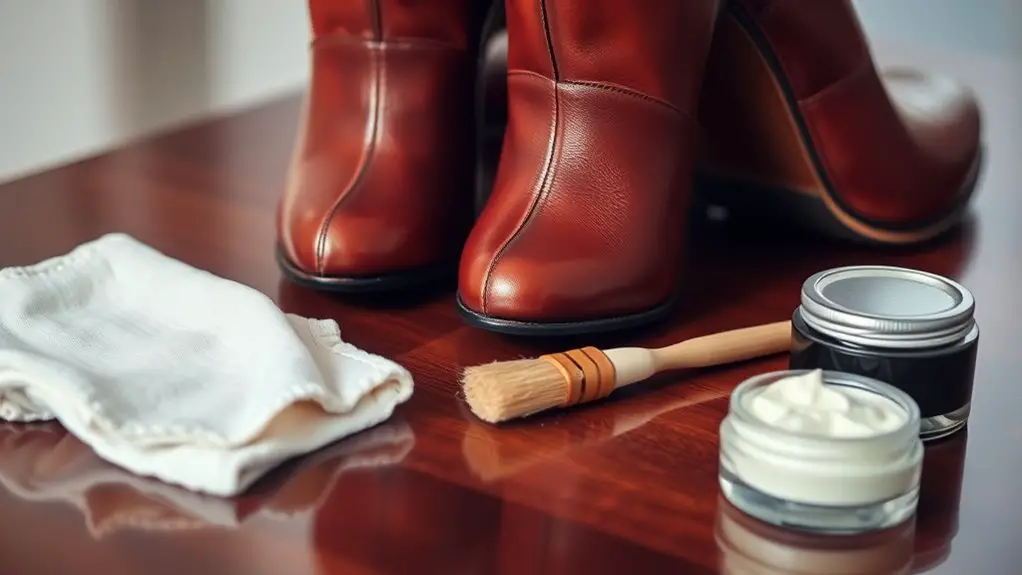
When it comes to polishing leather heels, choosing the right polish is vital for achieving a lustrous finish. You’ll want to apply it with care, using specific techniques to guarantee even coverage and avoid damage. Once polished, maintaining that shine is essential, so it’s important to know how to care for your leather properly.
Choosing the Right Polish
Choosing the right polish for your leather heels can make all the difference in maintaining their pristine appearance and prolonging their lifespan. With various polish types available, it’s crucial to choose one that suits your specific needs and matches the color of your heels.
- Cream Polishes: Nourish and hydrate leather.
- Wax Polishes: Provide a high shine and protection.
- Dye Polishes: Help with color matching and touch-ups.
- Liquid Polishes: Easy to apply, great for quick fixes.
- Foam Polishes: Light and effective for surface cleaning.
Application Techniques Explained
To guarantee your leather heels look their best, mastering the application techniques for polish is essential. Start by cleaning your heels with a soft cloth to remove dirt and dust, using gentle cleaning techniques. Once clean, apply a small amount of polish to a separate, clean cloth. Use circular motions to work the polish into the leather, ensuring even coverage. Focus on seams and creases, as they often absorb more wear. Allow the polish to sit for a few minutes to penetrate the leather. Finally, buff with a fresh cloth using brisk strokes to achieve a shine. These application methods enhance the leather’s appearance, ensuring your heels maintain their elegance while extending their lifespan.
Maintaining Polished Leather Heels
After applying polish to your leather heels, maintaining their polished look is key to keeping them in top condition. Regular care not only enhances their appearance but also extends their lifespan. Here’s how to guarantee they stay pristine:
- Use leather conditioner every few months to prevent cracking and dryness.
- Wipe shoes after each wear with a soft cloth to remove dust and dirt.
- Store heels properly in a dust bag or box to avoid scratches.
- Apply heel protection products to guard against scuffs and damage.
- Avoid water exposure; use a waterproof spray if needed.
Cleaning Suede and Nubuck Shoes
While suede and nubuck shoes exude luxury and style, they require specialized care to maintain their appearance. Start by using a soft-bristled brush designed for suede and nubuck to gently lift dirt and restore the nap. For tougher stains, consider employing suede restoration techniques like using a white eraser to rub away marks without damaging the material.
When cleaning, always test any nubuck cleaning products on a small, inconspicuous area first to verify they won’t alter the color or texture. If your shoes are particularly dirty, a nubuck cleaner spray can help remove grime effectively—just follow the instructions closely.
Finally, always let your shoes air dry away from direct heat, and avoid soaking them in water, as this can ruin the texture. With the right approach, your suede and nubuck shoes can remain stunning for years to come!
Preventive Care for Future Maintenance
Even if you love your heels and want them to last, implementing preventive care is essential for maintaining their beauty and longevity. By adopting proactive habits, you can greatly reduce wear and tear, ensuring your favorite pairs remain in great condition.
- Use shoe trees: They help maintain shape and prevent creasing.
- Store properly: Utilize preventive storage solutions, like dust bags or boxes, to keep them safe from dust and damage.
- Avoid extreme conditions: Keep your heels away from moisture and direct sunlight, which can cause fading and warping.
- Regular inspections: Periodically check for loose components or signs of wear; early detection can save you from costly repairs.
- Rotate pairs: Wearing different pairs helps minimize the strain on any single pair, extending their lifespan.
Frequently Asked Questions
Can I Use Bleach on My Shoe Heels?
You shouldn’t use bleach on your shoe heels; it can damage materials. Instead, consider bleach alternatives like vinegar or baking soda. Also, practice stain prevention by regularly cleaning and applying protective sprays to extend your heels’ life.
How Often Should I Clean My Heels?
You might’ve noticed how dirty heels can ruin an outfit. For ideal heel maintenance, clean ’em every few wears, or as needed. Following cleaning frequency guidelines keeps your shoes looking fresh and prolongs their life.
What Should I Do if the Stain Won’t Come Out?
If the stain won’t come out, try various stain removal techniques like baking soda or vinegar. For future prevention, regularly clean your heels and apply protective sprays, keeping them looking pristine and reducing stubborn stains.
Are There Any Home Remedies for Cleaning Heels?
You can try a baking soda and vinegar solution for tough stains. Alternatively, the toothpaste method works well, too. Adding some essential oils can enhance the scent while cleaning, making your heels look great again.
Can I Machine Wash My Fabric Heels?
You shouldn’t machine wash your fabric heels; it can damage their structure. Instead, focus on proper fabric care with gentle cleaning methods. Regular shoe maintenance guarantees they last longer and look great without risking harm.

